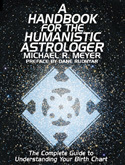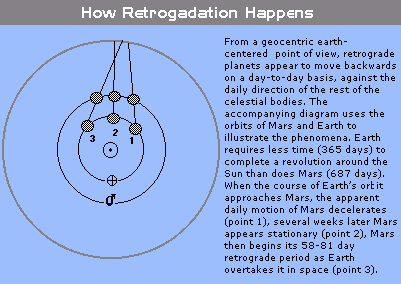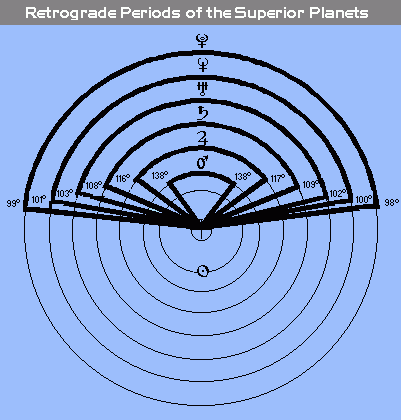
|
|
|
|
 A HANDBOOK FOR THE HUMANISTIC ASTROLOGER The Complete Guide to Understanding Your Birth Chart
Now available in
Paperback and eBook Formats 
When a planet is retrograde, its function goes against the grain of natural processes and compulsions.
A planet’s functional activities are particularly intense and focused at the beginning and end of its retrograde period, when it is stationary.  The planets beyond Earth’s orbit—Mars, Jupiter, Saturn, Uranus, Neptune and Pluto—are traditionally termed the "superior planets," while Venus and Mercury, with orbits inside Earth’s, are referred to as the "inferior planets."  The superior planets are always retrograde when approximately opposite the Sun. The diagram to the right shows the retrograde arc of each superior planet in bold. The further a planet’s orbit lies beyond Earth’s, the wider its retrograde arc and the longer its retrograde period. Mars, for instance, is retrograde only about 80 days every two years, while Pluto spends about five months retrograde each year. Mars retrograde in a horoscope, therefore, is a far more individual significance than Pluto retrograde. 
There is no substance in the popular myth that Mercury retrograde causes computer and mechanical failures.
|

Retrograde Periods
Astrology views the planets from a geocentric (earth-centered) perspective because we live on Earth and natal astrology requires a “person-centered” system depicting the space surrounding the birth of a person. The geocentric system, however, gives rise to the phenomenon of planetary retrogradation. A planet is said to be retrograde when its day-to-day motion appears to be moving in the sky against the motion of the other planets. The Sun and Moon are never retrograde, but all other planets spend a certain amount of time each year retrograde. See the accompanying sidebar for a graphic depiction of the phenomenon. 
When a planet is retrograde, its function symbolically runs against the natural current. Its processes may be turned inward, more or less powerfully impacting the personality, or it may find an unusual channel for outer expression. Each planet takes on its own special attributes when retrograde, and a great deal depends on how the retrograde planet is placed within the chart as a whole, as well as the person’s sex. Venus retrograde, for instance, carries a much different symbolism in the birth chart of a woman than it does in the horoscope of a man. Before you finish this book, you’ll have a good grasp on how to interpret the significance of retrograde planets in any horoscopic situation. A planet is said to be stationary during the beginning and the end of a retrograde period. It is the transitional moment when it appears to stand motionless before changing direction. The planet’s symbolic function is intensified and particularly focused during the days around its station. In a general sense, a planet’s retrograde period represents a time to retrace our steps, learn from past experience, resolve difficulties and tie-up loose-ends in the life-department represented by the retrograde planet. In the instance of a natal retrograde planet, this process is often internalized. The person may be much concerned with the issues, functions and processes symbolized by the retrograde planet, and attempts to understand, internalize and integrate them into the fabric of his or her life and personality. A basis for the counterpoint and internalized characteristics of a retrograde planet is provided by the astronomical fact that planets are retrograde only when they are roughly opposite to the Sun. As depicted in the accompanying diagram, with the exception the Moon, all planets roughly opposed the Sun in a horoscope are retrograde. 
In recent years much attention has been placed on the retrograde periods of transit planets, especially Mercury. Unfortunately, much of what has filtered down to the popular level has a “doom and gloom” quality which tends toward self-fulfillment. As discussed in-depth in Part Four, there is no substance—either in astrological tradition or in real-world observation—in claims that Mercury retrograde causes mechanical, computer and electronic failure. We may be more prone to error during such times, but no mysterious rays against which we are helpless are out there striking and knocking-out our computers and lines of communication.
| 1 |
2 |
3 |
4 |
Sun |
Mercury |
Venus |
Moon |
| Mars | Jupiter | Saturn | Uranus | Neptune | Pluto | Text and graphics copyright © 2000 by Michael R. Meyer.
All Rights Reserved.  mail@khaldea.com Web design and all data, text and graphics appearing on this site are protected by US and International Copyright and are not to be reproduced, distributed, circulated, offered for sale, or given away, in any form, by any means, electronic or conventional. Unless otherwise noted, all text, data and graphics appearing on this site are copyright © 2000-2010 by Michael R. Meyer. All Rights Reserved. See Notices for copyright statement, conditions of use, and disclaimer. |About|Calendar|Ephemeris| |Charts|Art Gallery|Library|Resources| |Shop|Links|Rudhyar Archival Project|Help| Web design and programming for this entire site copyright © 2000-2004 by Michael R. Meyer. |
